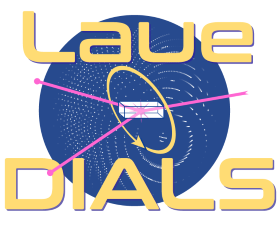laue_dials.command_line namespace
Submodules
laue_dials.command_line.compute_rmsds module
This script computes and plots RMSDs for a pair of DIALS experiment/reflection files.
laue_dials.command_line.find_spots module
This script performs spotfinding on an imported experiment.
laue_dials.command_line.index module
This script performs monochromatic indexing and optional scan-varying refinement.
laue_dials.command_line.integrate module
This script generates integrated MTZ files from refined data with predictions
- laue_dials.command_line.integrate.get_refls_image(refls, img_id)[source]
Get the set of reflections lying on a particular image.
- Parameters:
refls (dials.array_family.flex.reflection_table) – Reflection table.
img_id (int) – Image ID.
- Returns:
Reflection table for the specified image.
- Return type:
refls (dials.array_family.flex.reflection_table)
- laue_dials.command_line.integrate.integrate_image(img_set, refls, isigi_cutoff)[source]
Integrate predicted spots on an image.
- Parameters:
img_set (dxtbx_imageset_ext.Imageset) – Image set.
refls (dials.array_family.flex.reflection_table) – Reflection table.
isigi_cutoff (float) – I/SIGI threshold.
- Returns:
Updated reflection table.
- Return type:
flex.reflection_table
laue_dials.command_line.optimize_indexing module
This script optimizes Miller indices and wavelengths jointly.
- laue_dials.command_line.optimize_indexing.index_image(params, refls, expts)[source]
Reindex the given image reflections and update the experiment geometry.
- Parameters:
params (libtbx.phil.scope_extract) – Program parameters.
refls (dials.array_family.flex.reflection_table) – Reflection table for a single image.
expts (dxtbx.model.ExperimentList) – List of experiment objects.
- Returns:
The optimized experiment list with updated crystal rotations. refls (dials.array_family.flex.reflection_table): The optimized reflection table with updated wavelengths.
- Return type:
expts (dxtbx.model.experiment_list.ExperimentList)
laue_dials.command_line.plot_wavelengths module
This script histograms the wavelengths present in a reflection table.
laue_dials.command_line.predict module
This script predicts reflections for integration
- laue_dials.command_line.predict.predict_spots(lam_min, lam_max, d_min, refls, expts)[source]
Predict spots given a geometry.
- Parameters:
lam_min (float) – Minimum wavelength for the beam spectrum.
lam_max (float) – Maximum wavelength for the beam spectrum.
d_min (float) – Minimum d-spacing for reflecting planes.
refls (dials.array_family.flex.reflection_table) – The reflection table.
expts (dxtbx.model.experiment_list.ExperimentList) – The experiment list.
- Returns:
Predicted reflection table.
- Return type:
final_preds (dials.array_family.flex.reflection_table)
laue_dials.command_line.refine module
This script handles polychromatic geometry refinement.
- laue_dials.command_line.refine.correct_identifiers(expts, refls)[source]
Correct identifiers in case of skipped images.
- Parameters:
expts (dxtbx.model.ExperimentList) – Experiment list.
refls (flex.reflection_table) – Reflection table.
- Returns:
The corrected experiment list with corrected identifiers. corrected_refls (dials.array_family.flex.reflection_table): The corrected reflection table with updated identifiers.
- Return type:
corrected_expts (dxtbx.model.experiment_list.ExperimentList)
- laue_dials.command_line.refine.refine_image(params, expts, refls)[source]
Refine image given parameters, experiments, and reflections.
- Parameters:
params (libtbx.phil.scope_extract) – Refinement parameters.
expts (dxtbx.model.ExperimentList) – Experiment list.
refls (flex.reflection_table) – Reflection table.
- Returns:
The refined experiment list with updated geometry. refined_refls (dials.array_family.flex.reflection_table): The refined reflection table with updated wavelength and centroid data.
- Return type:
refined_expts (dxtbx.model.experiment_list.ExperimentList)
laue_dials.command_line.sequence_to_stills module
Split a sequence into a set of stills.
Example
laue.sequence_to_stills monochromatic.expt monochromatic.refl
- laue_dials.command_line.sequence_to_stills.run(args=None, phil=<libtbx.phil.scope object>)[source]
Validate the arguments and load experiments/reflections for sequence_to_stills.
- Parameters:
args (list) – Command-line arguments.
phil – Working phil scope.
- Returns:
None
- laue_dials.command_line.sequence_to_stills.sequence_to_stills(experiments, reflections, params)[source]
Split a sequence into a set of stills.
This function takes a sequence of experiments and corresponding reflections and splits it into a set of stills. Each still is associated with a specific scan point within the original sequence. The resulting experiments and reflection tables for the stills are returned.
- Parameters:
experiments (List[dxtbx.model.experiment_list]) – The list of experiments representing the sequence.
reflections (List[dials.array_family.flex.reflection_table]) – The list of reflection tables corresponding to the experiments.
params (libtbx.phil.scope_extract) – Program parameters.
- Returns:
A tuple containing the following: - A list of Experiment objects representing the split stills. - A list of reflection_table objects containing the split reflections for each still.
- Return type:
Tuple[List[dxtbx.model.experiment_list.Experiment], List[dials.array_family.flex.reflection_table]]
laue_dials.command_line.version module
This script performs spotfinding on an imported experiment.
